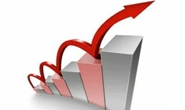Economy

ISM Manufacturing Index Bounces Back in March
Written by Sandy Williams
April 1, 2019
The March ISM manufacturing PMI bounced back from a two-year low recorded in February. The Index rose to 55.3 from 54.2 supported by gains in new orders and employment, said Timothy Fiore, chairman of the Institute of Supply Management business survey committee.
Indexes for new orders and production rose 1.9 and 1.0 percentage points to 57.4 and 55.8, respectively. The supplier delivery index decreased to 54.2 from 54.9 in February. Inventories also decreased, losing 1.6 percentage points from last month for a reading of 51.8. The customer inventories index rose, but inventories were still considered too low at a reading of 42.7. A reading above 50 indicates expansion.
The prices index jumped 4.9 points to 54.3, indicating that raw materials resumed price growth after contracting for two months. The index for employment gained 5.2 points to register 57.5.
Import and export indices showed slower growth in February. The export index inched downward 1.1 points to 51.7, while the import index lost 4.2 points to settle at 51.1.
“The manufacturing sector continues to expand, demonstrated by improvements in the PMI three-month rolling average, which is consistent with overall manufacturing growth projections,” said Fiore.
Sixteen of the 18 manufacturing industries reported growth in March, including fabricated metal products, primary metals and machinery at the bottom of the ordered list.
Following are some comments from survey respondents:
“Experienced a reduction in orders, with forecasted softness going into Q2.” (Primary Metals)
“General procurement levels remain strong based on demand. Backlog for domestic new and repaired equipment continues to grow. Production meeting customer delivery requirements is a challenge. Still experiencing a skills gap in hiring qualified shop personnel, machinists and mechanics.” (Fabricated Metal Products)
“Business remains very strong amid rumors of a slowdown, but forecasts do not indicate this. Electronics are at tight capacity from manufacturers, with no [change] in the near future.” (Transportation Equipment)
“Current weather conditions causing significant delivery delays [and] diminishing our production capabilities.” (Machinery)
“Strong business momentum coming into January and early February has slowed to typical seasonal business conditions for our industry.” (Miscellaneous Manufacturing)
“Steel tariffs continue to put upward pressure on our input costs. The government shutdown delayed the process of gaining exemptions to the tariffs.” (Petroleum & Coal Products)
“Weather in the domestic market is constraining homebuilding across the nation — too wet in the south, severe winter in the north. Expectations are that a homebuilding backlog is growing, and a surge of domestic business will come in May and June. Internationally, the Chinese trade war is still holding business back, but expectations are that in April or May business will spring back materially as tariffs resolve.” (Wood Products)
“Steel in the U.S. remains strong, driving numerous product lines.” (Nonmetallic Mineral Products)
“Brexit continues to be a concern, despite the fact that our organization has already rolled out a plan to minimize its impact.” (Chemical Products)
“Awaiting with anticipation the outcome of the U.S.-China trade deal.” (Plastics and Rubber Products)

Sandy Williams
Read more from Sandy WilliamsLatest in Economy

Architecture billings continue to slide in March
Architecture firms said billings continued to decline in March, according to the latest Architecture Billings Index (ABI) released by the American Institute of Architects (AIA) and Deltek.

Beige Book shows concerns about trade policy
Manufacturing was mixed, but two-thirds of districts said activity was little changed or had declined.

New York state manufacturing index drops again in April
Firms were pessimistic, with the future general business conditions index falling to its second lowest reading in the more than 20-year history of the survey

Construction adds 13,000 jobs in March
The construction sector added 13,000 jobs, seasonally adjusted, in March, but tariffs could undermine the industry.

Supply chains, end-users brace for impact from tariffs
Supply chains are working through what the tariffs mean for them
